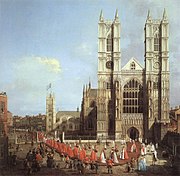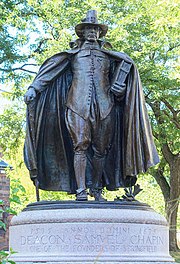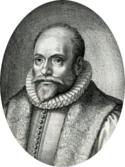Arminianism in the Church of England
| Part of a series on the |
| History of the Church of England |
|---|
 |
| Part of a series on |
| Puritans |
|---|
 |
Characteristics
The term "
While the term "Arminian" was widely used in debates of that time, and was subsequently co-opted as convenient to match later
Factional struggles within the Church around bishop William Laud, supported by King Charles I, involved both ecclesiastical matters and political control of the Church. That control issue was central for the lay Parliamentary Puritans, who campaigned strongly under an anti-Arminian banner.
Elizabethan anti-Calvinists
The Church of England's embrace of the Elizabethan Settlement allowed for a large-scale acceptance of Calvinist views. Such intense debates as occurred on theological points were localised, in contrast to the widespread tension over church polity.
Predestination
A dissident voice was Richard Thomson. But anti-Calvinism was closed down as far as discussion in print was concerned. Thomson was refused permission to print his Diatriba de amissione et intercisione gratiae, et justificationis later in the 1590s.[3]
Descensus controversy
The third of the Thirty-Nine Articles affirmed the
Jacobean approaches
During the period 1603 to 1625 Arminianism took shape as a Dutch religious party, became involved by successive appeals to secular authority in high politics, and was crushed. In the same period English Arminianism existed (if at all) almost unavowed on paper, and since anti-Calvinist literature was censored, had no clear form until 1624 and a definite controversy.
Footholds for Arminian views
Certain churchmen are now labelled by historians as "proto-Arminian". These include prominent bishops of the period around 1600:
George Abbot suspected William Laud at an early stage of his career of anti-Calvinism; and attempted to block Laud's election as President of St John's College, Oxford. Laud, however, had supporters in the "moderate" group who would later emerge as the recognisable "Durham House" faction, around Richard Neile. The election of Laud was eventually allowed to stand by the king, after much intrigue.[12] Some other heads of houses showed close acquaintance with the Dutch Arminian literature: Jerome Beale, Samuel Brooke, Matthew Wren.[13]
The international Arminian conflict and the Synod of Dort
Opponents of Conrad Vorstius, successor to Arminius, led by Sibrandus Lubbertus, communicated with George Abbot. King James issued a pamphlet against Vorstius in 1612; he also recruited Richard Sheldon and William Warmington to write against him.[14] Abbot had anti-Arminian works written, by Sebastian Benefield and Robert Abbot, his brother (In Ricardi Thomsoni Angli-Belgici diatribam, against Thomson); his reception in 1613 of Hugo Grotius, the leading Dutch Arminian intellectual, was chilly (unlike the king's).[15] James chose to back the Huguenot Pierre Du Moulin as a theologian to unify the French Protestants, an opponent of the Arminian Daniel Tilenus, and was successful by the synod at Alès in 1620 in his aims.[16]
The Elizabethan debate was at this time revisited, in the context of the overt religious conflicts and battle lines in the
In pursuit of wider aims of Protestant reconciliation (within Calvinism, and between Calvinists and Lutherans), James I both promoted the importance of the Synod of Dort (1618) by sending a learned delegation, and approved of its conclusions. He was prepared at that point to allow the Remonstrant (Arminian) teaching to be written off as a return of Pelagianism. On the other hand, James wished the Synod's conclusions to close down the debate on the specific theological points involved: particularly on predestination. As far as his own kingdom of England was concerned, he issued instructions via George Abbot in 1622 suggesting restrictions on preaching, on the topics involved, and a moderate approach.[19]
The Gagg controversy
In 1624, a thitherto obscure Cambridge scholar, Richard Montagu, obtained royal permission to publish A New Gagg for an Old Goose. The book was framed as a rebuttal of a Catholic critique of the Church of England. In response, Montagu argued that the Calvinist positions objected to were held only by a small, Puritan minority in the Church of England, and that the majority of clergy in the Church of England rejected high Calvinism.
Caroline divines and Arminianism
The initial accusation of an Englishman of Arminianism has been dated to 1624.
Arminianism and Laudianism
Laudianism, the programme of William Laud as Archbishop of Canterbury from 1633 to shape the Church of England in terms of liturgy, discipline, and polity, has only with difficulty been equated by historians with the operation of an actual Arminian faction in the Church of England. In the factional church disputes under Charles I, however, this was certainly a common accusation.
Liberal Arminianism
What has been called a "liberal" Arminianism, distinct from Laudianism, emerged in the 1630s in the circle around Lucius Cary, 2nd Viscount Falkland.[22] Given the involvement in this group of clerics who would hold important bishoprics after 1660, most obviously Gilbert Sheldon, this strand of Arminianism has been seen as significant for the tradition of the Church of England in the longer term.
Hooker's Ecclesiastical Polity
A writer of a previous generation, Richard Hooker, was used by Laudians to supply a basis for their arguments in debate, in particular with the king. His Ecclesiastical Polity supplied arguments on justification, less individualistic than the Calvinistic norm; and these were adopted by John Cosin in his Collection of Private Devotions.[23] On the other hand, modern scholars generally regard Hooker as a theologian within the internationalist Reformed mainstream.[24]
Arminianism and absolutist views
David Owen from Anglesey was one "proto-Arminian" who both advocated the divine right of kings, and regarded Hooker's works as supporting it. His works were brought back into print two decades after his death in 1623.[23][25] Of the two most notorious clerical supporters of royal prerogative of the reign of Charles I, Robert Sibthorpe at least had Arminian associations (with Owen and others in the diocese of Peterborough); while Roger Maynwaring did not.[26]
Debate on Tyacke's view
Tyacke's view on English Arminianism as innovative and disruptive in the early Stuart period had a significant effect on historiography: Kevin Sharpe wrote that
[...] Nicholas Tyacke's thesis on the rise of English Arminianism became the mainstay of
Conrad Russell's account of the origins of the English civil war.— Sharpe 2000, p. 347
But it also has been much contested, notably by Julian Davies who sees "Carolinism", that is Charles I and his insistence on sacramental kingship as opposed to the rule of the King-in-Parliament, as the major factor.[27]
Notes
- ^ "Of the various terms which can be used to describe the thrust of religions change at the time Arminian is the least misleading. It does not mean that the Dutch theologian Jacobus Arminius was normally the source of the ideas so labelled. Rather Arminian denotes a coherent body of anti-Calvinist religious thought, which was gaining ground in various regions of early seventeenth-century Europe." Tyacke 1990, p. 245.
References
- ^ Tyacke 1990, p. 245.
- ^ Lee 1900.
- ^ a b Moore 2008.
- ^ Richardson 2004.
- ^ Nijenhuis 1980, p. 168.
- ^ Summerson 2004.
- ^ Gordon & Marshall 2000, p. 119.
- ^ Sommerville 1986, p. 217.
- ^ Fincham 2008.
- ^ Foster 2004.
- ^ Rabb 2017.
- ^ Fincham 2011.
- ^ Milton 2002, p. 436.
- ^ Carlyle 1897.
- ^ Patterson 2000, p. 143.
- ^ Armstrong & Larminie 2008.
- ^ Tyacke 2001, pp. 224–225.
- ^ White 2002, pp. 122–123.
- ^ Patterson 2000, pp. 280–282.
- ^ Schwartz 1973, pp. 41–68.
- ^ Foster 2005.
- ^ Bremer & Webster 2006, p. 312.
- ^ a b Brydon 2006, pp. 47–48.
- ^ Brydon 2006, p. 4.
- ^ Cranfield 2006.
- ^ Larminie 2008.
- ^ Davies 1992.
Sources
- Armstrong, Brian G.; Larminie, Vivienne (4 October 2008). "Du Moulin, Pierre". doi:10.1093/ref:odnb/19430. (Subscription or UK public library membershiprequired.)
- Bremer, Francis J.; Webster, Tom (2006). Puritans and Puritanism in Europe and America: A Comprehensive Encyclopedia. ABC-CLIO. ISBN 978-1-57607-678-1.
- Brydon, Michael (2006). The Evolving Reputation of Richard Hooker: An Examination of Responses, 1600-1714. Oxford: OUP. ISBN 978-0-19-920481-6.
- Carlyle, Edward Irving (1897). . In Lee, Sidney (ed.). Dictionary of National Biography. Vol. 52. London: Smith, Elder & Co.
- Cranfield, Nicholas W. S. (28 September 2006). "Owen, David". doi:10.1093/ref:odnb/20989. (Subscription or UK public library membershiprequired.)
- Davies, Julian (1992). The Caroline Captivity of the Church: Charles I and the Remoulding of Anglicanism, 1625-1641. Oxford: Clarendon Press. ISBN 978-0-19-820311-7.
- Fincham, Kenneth (3 January 2008). "Dove, Thomas". doi:10.1093/ref:odnb/7952. (Subscription or UK public library membershiprequired.)
- Fincham, Kenneth (6 January 2011). "Abbot, William". doi:10.1093/ref:odnb/4. (Subscription or UK public library membershiprequired.)
- Foster, Andrew (23 September 2004). "Lindsell, Augustine". doi:10.1093/ref:odnb/16721. (Subscription or UK public library membershiprequired.)
- Foster, Andrew (26 May 2005). "Durham House group". doi:10.1093/ref:odnb/72182. (Subscription or UK public library membershiprequired.)
- Gordon, Bruce; Marshall, Peter (2000). The Place of the Dead: Death and Remembrance in Late Medieval and Early Modern Europe. Cambridge: University Press. ISBN 978-0-521-64518-8.
- Larminie, Vivienne (3 January 2008). "Maynwaring [Manwaring], Roger (1589/90?–1653), bishop of St David's". doi:10.1093/ref:odnb/18011. (Subscription or UK public library membershiprequired.)
- Lee, Sydney (1900). . In Lee, Sidney (ed.). Dictionary of National Biography. Vol. 61. London: Smith, Elder & Co.
- Milton, Anthony (2002). Catholic and Reformed: The Roman and Protestant Churches in English Protestant Thought, 1600-1640. Cambridge University Press. ISBN 978-0-521-89329-9.
- Nijenhuis, Willem (1980). Adrianus Saravia (ca. 1532-1613): Dutch Calvinist, First Reformend Defender of the English Episcopal Church Order on the Basis of the Ius Divinum. BRILL. ISBN 90-04-06194-0.
- Patterson, W. B. (2000). King James VI and I and the Reunion of Christendom. Cambridge: University Press. ISBN 978-0-521-79385-8.
- ISBN 978-1-4008-8752-1.
- Richardson, William (23 September 2004). "Bilson, Thomas". doi:10.1093/ref:odnb/2401. (Subscription or UK public library membershiprequired.)
- S2CID 145503815.
- ISBN 978-0-521-66409-7.
- Sommerville, J. P. (1986). Politics and ideology in England, 1603-1640. Longman. ISBN 9780582494329.
- Summerson, Henry (23 September 2004). "Hill, Adam". doi:10.1093/ref:odnb/13266. (Subscription or UK public library membershiprequired.)
- Moore, Jonathan D. (3 January 2008). "Thomson, Richard". doi:10.1093/ref:odnb/27320. (Subscription or UK public library membershiprequired.)
- Tyacke, Nicholas (1990). Anti-Calvinists: the rise of English Arminianism, c. 1590-1640. Oxford: Clarendon. ISBN 978-0-19-820184-7.
- Tyacke, Nicholas (2001). Aspects of English Protestantism C. 1530-1700. Manchester: University Press. ISBN 978-0-7190-5392-4.
- White, Peter (2002). Predestination, Policy and Polemic: Conflict and Consensus in the English Church from the Reformation to the Civil War. Cambridge: University Press. ISBN 978-0-521-89250-6.
Further reading
- Cust, Richard (2014), Charles I: A Political Life
- Cust, Richard; Hughes, Ann (2014). Conflict in Early Stuart England: Studies in Religion and Politics 1603-1642. Routledge. ISBN 978-1-317-88502-3.
- Fielding., John (1993). "Arminianism in the Localities: Peterborough Diocese, 1603-1642". In Fincham, Kenneth (ed.). The Early Stuart Church, 1603–1642. Macmillan. ISBN 978-1-349-22771-6.
- Hoenderdaal, G. J. (1975). "The Debate About Arminius Outside the Netherlands". In Scheurleer, Theodoor Herman Lunsingh; Posthumus Meyjes, Guillaume Henri Marie (eds.). Leiden University in the Seventeenth Century: An Exchange of Learning. Brill. ISBN 978-90-04-04267-4.
- Lake, Peter G. (February 1987). "Calvinism and the English Church 1570-1635". Past & Present. 114 (114): 32–76. JSTOR 650960.
- Lambert, Sheila (1989). "Richard Montagu, Arminianism and Censorship". Past & Present. 124 (124): 36–68. JSTOR 650892.
- Park, Jae-Eun (2016). "John Plaifere (d.1632) on conditional predestination: a well-mixed version ofscientia mediaand resistible grace". Reformation & Renaissance Review. 18 (2): 155–173. S2CID 159493800.
- Porter, Harry Culverwell (1958). Reformation and Reaction in Tudor Cambridge. Cambridge: CUP Archive. GGKEY:QTDBXABUW2J.
- Tyacke, N. R. N. (17 May 1973). "Puritanism, Arminianism and Counter Revolution". In Conrad Russell (ed.). The Origins of the English Civil War. Macmillan. ISBN 978-1-349-15496-8.
- Tyacke, Nicholas (May 1987). "Debate: The Rise of Arminianism Reconsidered". Past & Present (115): 201–216. JSTOR 650844.
- White, Peter (November 1983). "The Rise of Arminianism Reconsidered". Past & Present. 101 (101): 34–54. JSTOR 650669.

